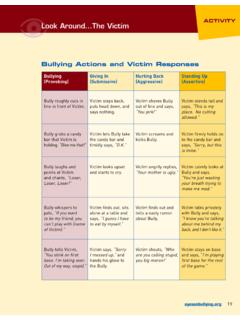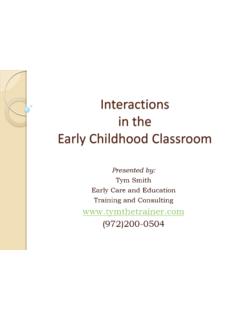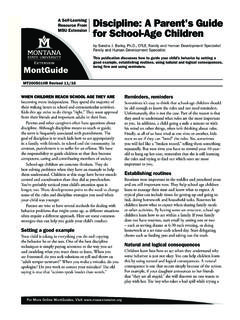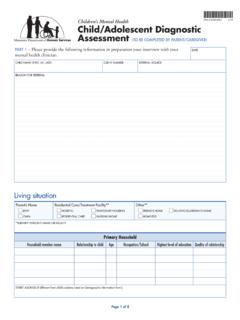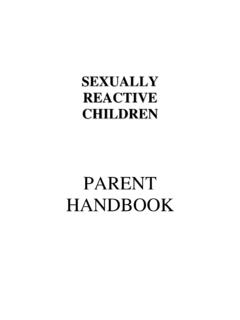Transcription of Eyes on Bullying Toolkit
1 Everyone plays a role. What s your role?Eyes on Bullying Toolkit What Can You Do?Ron Slaby, PhD is a developmental psychologist, educator, and research scientist. Through his pioneering work at Harvard University, Education Development Center, and Children s Hospital Boston, Dr. Slaby has helped to shape an international agenda on the prevention of youth violence and the influence of media on children and youth. His extensive writings include: Early Violence Prevention: Tools for Teachers of Young Children, and Aggressors, Victims and Bystanders: Thinking and Acting to Prevent Storey, EdD is an educator, designer, and producer who creates innovative educational media resources for children, parents, and teachers.
2 Her expertise includes Bullying prevention and the healthy development of children. A regular consultant for education, media, and technology organizations, Dr. Storey has developed and produced children s television programs, websites, and a variety of educational materials that have had a major impact on the lives of millions of families, educators, and professional on Bullying .. What Can You Do?A Toolkit to prevent Bullying in children s livesThe Eyes on Bullying Toolkit was developed and written by: Kim Storey, Ron Slaby, Melanie Adler, Jennifer Minotti, and Rachel Katz, at Education Development Center, Inc. Funding was provided by the IBM Global Work/Life Fund.
3 2008, 2013 by Education Development Center, Inc. All rights people depicted in the photographs that appear in this publication are models and used for illustrative purposes Development Center, Inc. 43 Foundry Ave, Waltham, MA 02453 USAT oolkit ObjectivesSuccessful Bullying prevention includes education, preparation, and teamwork. This Toolkit provides specific insights, strategies, activities, and resources to address Bullying . It is designed especially for parents, caregivers, educators, and healthcare providers who work with children and youth in homes, early childhood programs, schools (K-12), afterschool and youth programs, camps, and healthcare Toolkit will help you.
4 1 Understand the extent, seriousness, and dynamics of bullying2 Recognize and respond early and effectively to behaviors that can lead to bullying3 Learn about new, effective strategies for preventing bullying4 Prepare children to recognize and respond effectively to early Bullying behavior5 Teach children how everyone bullies, victims, bystanders, and supportive adults can help prevent and stop bullying6 Create an environment where everyone understands that Bullying behaviors are unacceptable, harmful, and preventable 7 Empower yourself and children to actively intervene to prevent and stop bullyingSeeing the big Education Development Center, Inc. 43 Foundry Ave, Waltham, MA 02453 USAT able of Contents PageIntroduction 1 User s Guide 21 A New Look 3 Introduces the issue of Bullying and answers the question What is Bullying ?
5 An activity encourages adults and children to share their own experiences with Bullying . 2 Look Out 6 Explains why Bullying can sometimes be difficult to see. It also describes cyberbullying. An activity encourages children to understand the behaviors related to the different forms of Bullying and to discuss ways to report Bullying . 3 Look Around 10 Examines the roles of bully, victim, and bystander. It includes three activities: A questionnaire helps children and adults reflect on their own beliefs about Bullying ; a role-playing activity allows children to practice their assertiveness skills; and a quiz challenges perceptions about the role of bystander.
6 4 Look Strategically 25 Offers specific recommendations and strategies for addressing Bullying when it occurs. An activity presents three potential Bullying situations and invites children to explore different options for changing the Bullying game. 5 Look Ahead 33 Presents a systematic approach to creating an environment where everyone takes responsibility for preventing Bullying . 6 Look It Up 35 Includes useful resources and references on Bullying prevention. Never doubt that a small group of thoughtful, committed citizens can change the world; indeed, it s the only thing that ever has. Margaret MeadFor more information on the topics introduced in this Toolkit , visit the Eyes on Bullying website: OPENER If you do not intervene, bullies, victims, and bystanders will continue to believe in the power of Bullying , rather than the power of prevention.
7 They will continue to let Bullying Bullying through new Bullying can happen anywhere children gather. Yet, with greater understanding of the extent, seriousness, and dynamics of this problem, the amount and consequences of Bullying can be greatly reduced. Parents, caregivers, healthcare providers and educators working together can play crucial roles in Bullying prevention in homes, early childhood programs, schools, afterschool and youth programs, camps, and healthcare settings. You are on the front lines, likely to see Bullying when it occurs and establish the rules needed to prevent are the adults children turn to for help resolving problems or to confide their concerns.
8 You are in a unique position to help them navigate the challenges of their social world. Yet, the issues surrounding Bullying can be complex. Knowing how and when to intervene requires effective strategies and practice. Eyes on Bullying offers a variety of tools that can help you look at and understand Bullying in a new way, reexamine your own knowledge and beliefs about Bullying , and shape the beliefs and behaviors of the children in your PhilosophyWe believe that to prevent Bullying in children s lives, children and adults must: Take a new look at the ways they think about Bullying Understand how their actions or inaction can either prevent or escalate Bullying behaviors Take responsibility and action for preventing Bullying Learn and teach others successful strategies and skills to prevent Bullying Create an environment where rules of conduct are clear, children feel safe, and everyone understands that Bullying will not be toleratedIntroduction2 materials can be used in a variety of settings, with both children and adults.
9 Activities can be readily adapted to meet the needs of individuals and groups as well as children of all ages. Specific suggestions for doing so are included throughout the Toolkit . Additional information on issues relevant to specific age groups and settings is included on the Eyes on Bullying website: To benefit most from these Prepare ahead of time. Before using the materials, review the content and activities. Consider the issues they raise and how they apply to the children in your care. Try out the activities with colleagues or other adults, to see how they work and to examine your own knowledge and beliefs about Bullying . 2 Proceed through the Toolkit sequentially, if possible.
10 The Toolkit begins with an examination of individual experiences, values, and beliefs around Bullying , and then moves toward developing a team approach to Bullying prevention and creating a Bullying -free environment. The activities build on one another. 3 Realize that change happens slowly. Changing knowledge, beliefs, and behaviors takes time. Children and adults need multiple opportunities to practice. Instead of limiting Bullying prevention to a single session, consider incorporating Toolkit activities in ongoing events (such as staff trainings) or periods when children are accustomed to addressing serious issues (such as open-circle times, cabin chats, or family meetings).
